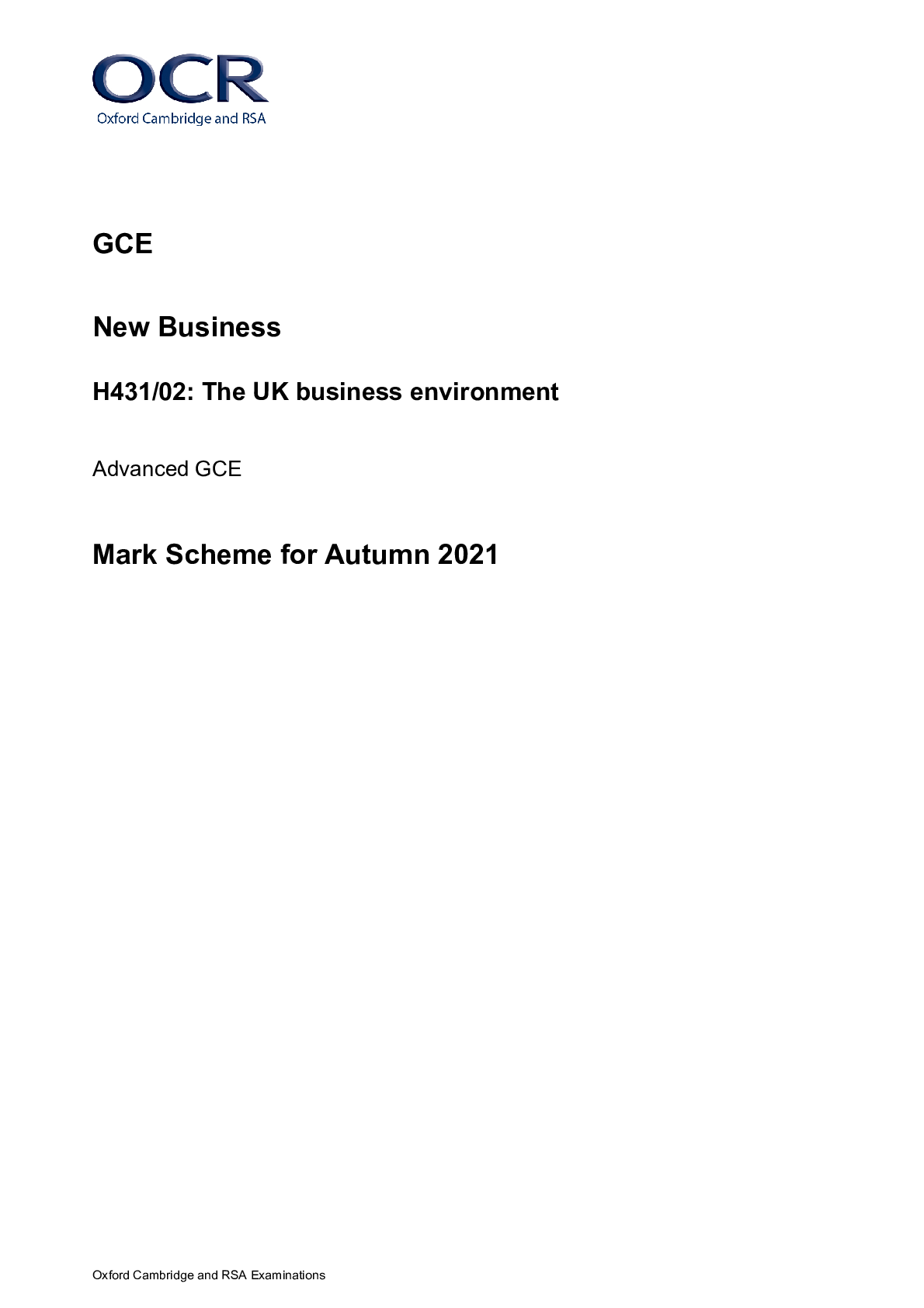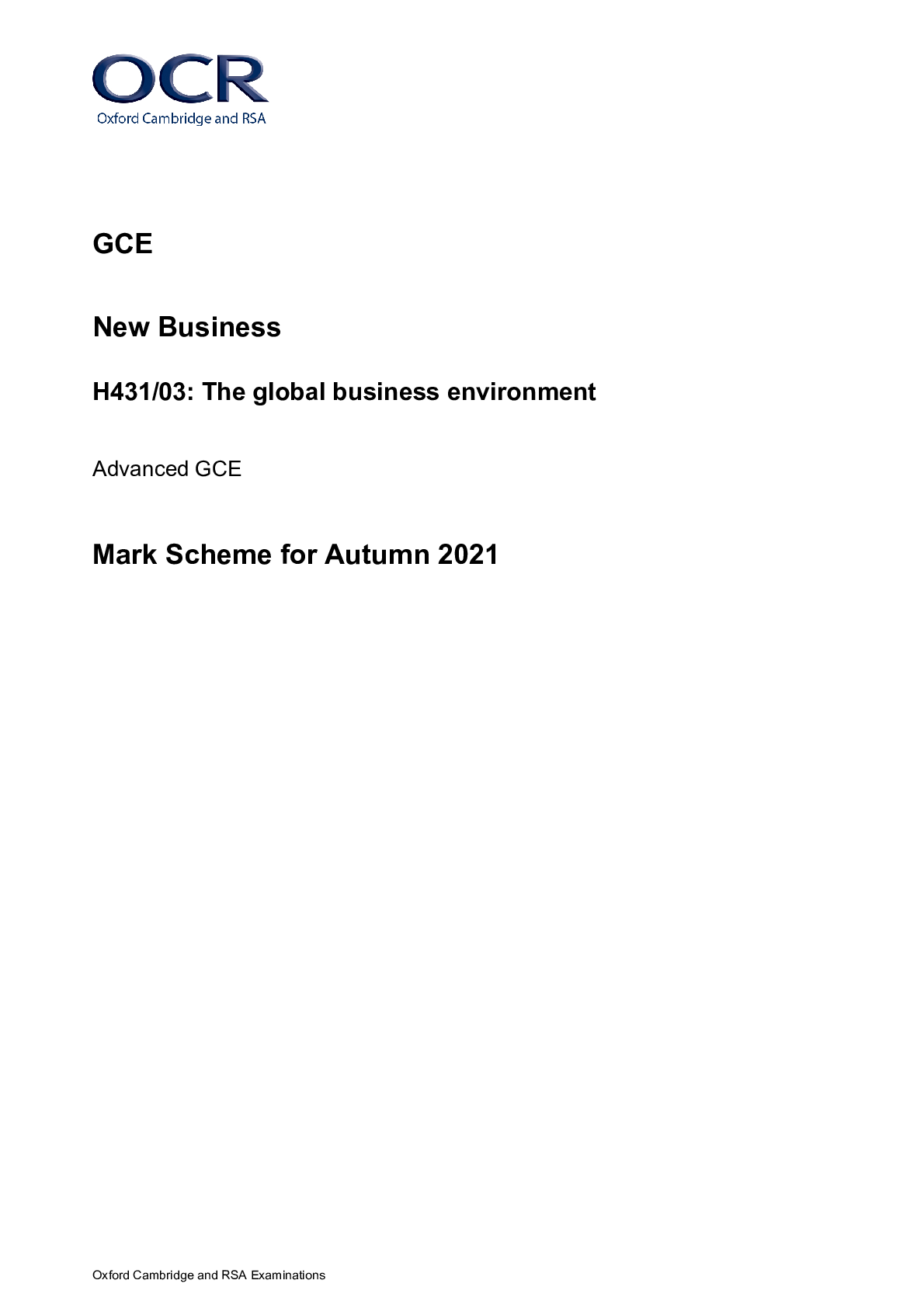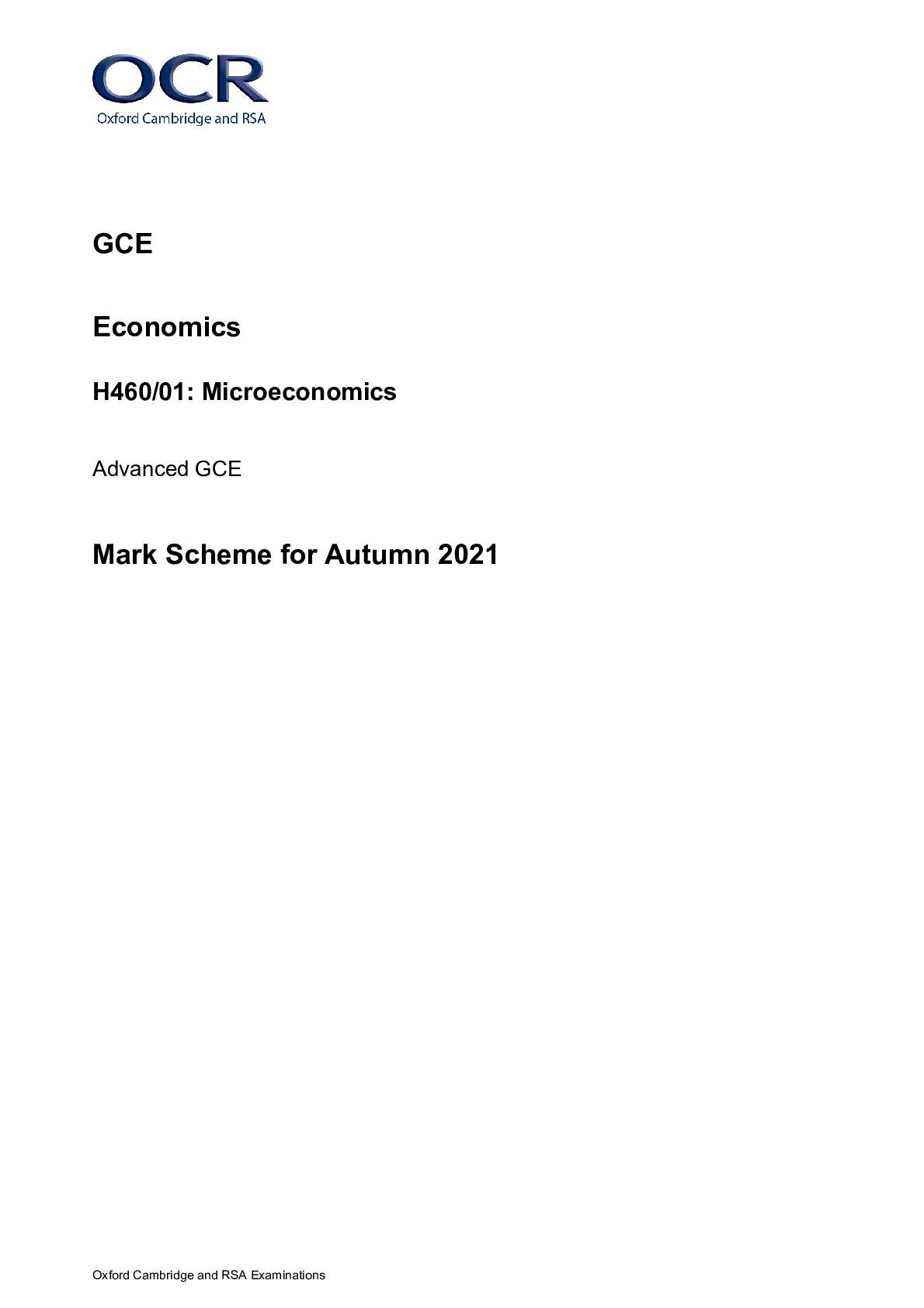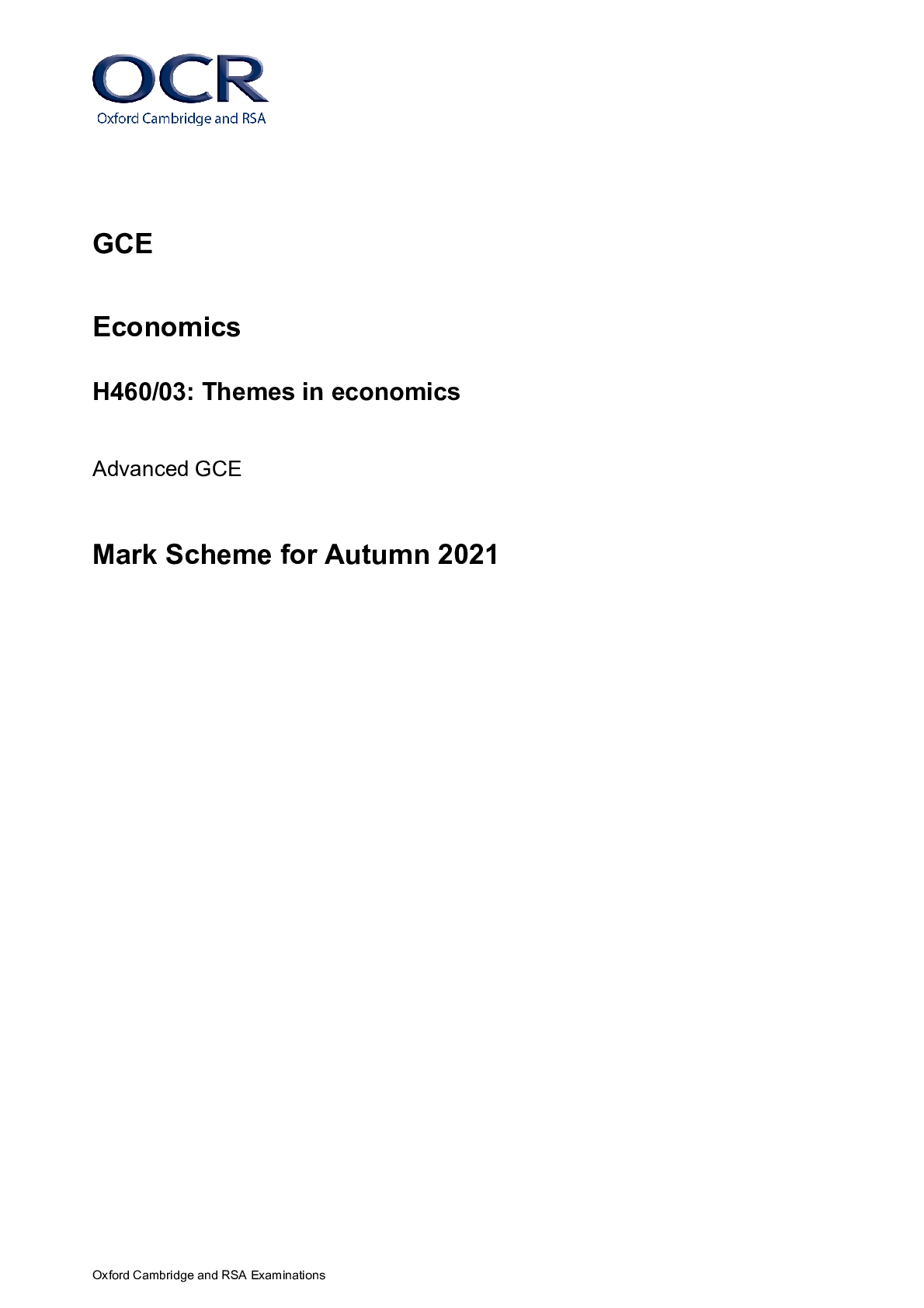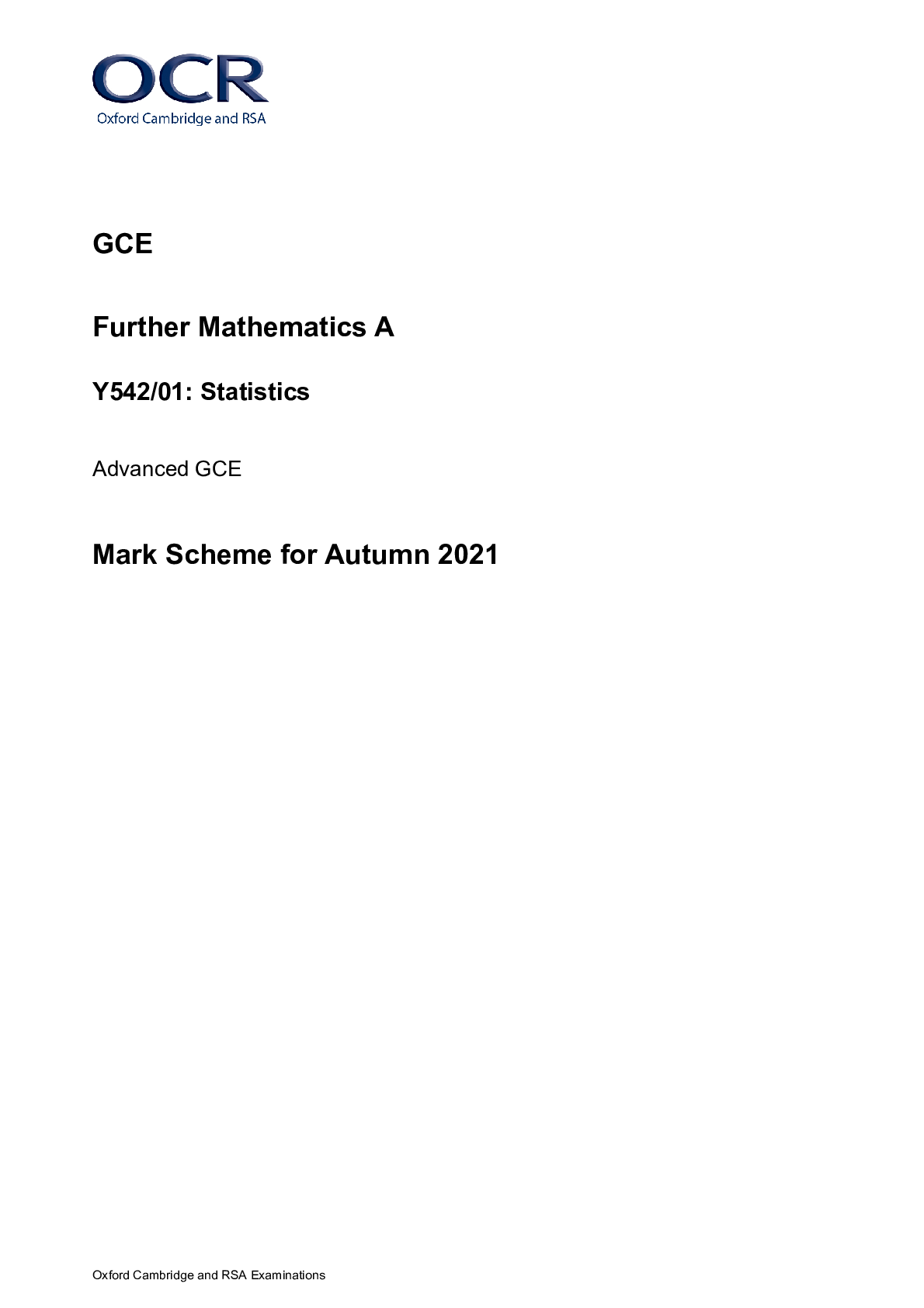Religious Studies > MARK SCHEME > GCE Religious Studies H573/03: Developments in Christian thought Advanced GCE Mark Scheme for Novemb (All)
GCE Religious Studies H573/03: Developments in Christian thought Advanced GCE Mark Scheme for November 2020
Document Content and Description Below
GCE Religious Studies H573/03: Developments in Christian thought Advanced GCE Mark Scheme for November 2020 Oxford Cambridge and RSA Examinations GCE Religious Studies H573/03: Development... s in Christian thought Advanced GCE Mark Scheme for November 2020Oxford Cambridge and RSA Examinations OCR (Oxford Cambridge and RSA) is a leading UK awarding body, providing a wide range of qualifications to meet the needs of candidates of all ages and abilities. OCR qualifications include AS/A Levels, Diplomas, GCSEs, Cambridge Nationals, Cambridge Technicals, Functional Skills, Key Skills, Entry Level qualifications, NVQs and vocational qualifications in areas such as IT, business, languages, teaching/training, administration and secretarial skills. It is also responsible for developing new specifications to meet national requirements and the needs of students and teachers. OCR is a not-for-profit organisation; any surplus made is invested back into the establishment to help towards the development of qualifications and support, which keep pace with the changing needs of today’s society. This mark scheme is published as an aid to teachers and students, to indicate the requirements of the examination. It shows the basis on which marks were awarded by examiners. It does not indicate the details of the discussions which took place at an examiners’ meeting before marking commenced. All examiners are instructed that alternative correct answers and unexpected approaches in candidates’ scripts must be given marks that fairly reflect the relevant knowledge and skills demonstrated. Mark schemes should be read in conjunction with the published question papers and the report on the examination. © OCR 20202 Indicative content – Responses might include: Guidance 1. ‘The God of love would not elect a limited number of people to salvation.' Discuss. AO1 Candidates may demonstrate knowledge and understanding through the use of some of the following ideas: • election means ‘choice’ and refers to the biblical notion of God calling each person to salvation • salvation has a wide range of meanings but in traditional Christianity means to come fully into God’s presence in the Kingdom of God in heaven • it means to experience perfection in the beatific vision or not (as hell or in a state of estrangement from God) • election when coupled with the doctrine of predestination explains why many people might be called to salvation but not everyone is chosen • the idea is contained in Matthew 25:31-46 (the Parable of the Sheep and the Goats) – God’s last judgement – where only the righteous are chosen to enter the heavenly kingdom and those who thought they were righteous but have not acted justly are excluded • predestination suggests that the divine decree or God’s judgement occurs either at the beginning of creation or immediately after the Fall • Christian theologians have developed various versions of election and predestination: unlimited election in which God calls all because Christ died for the sins of the whole world; limited election in which God calls a few people because only a few are worthy of heaven and Christ’s death atones only for them. AO2 Candidates may demonstrate evaluation and analysis through the use of some of the following arguments. • Some candidates might argue that the God of love would not elect a limited number of people to salvation because: o God loves all his creation and it would be unjust and contrary to His nature to condemn some to eternal punishment therefore as no one is excluded from God’s love and therefore all people will, at some stage, be saved (universalism) o limited election undermines human free will and moral responsibility, especially when coupled with strong version of predestination where God appears to have elected the righteous even before or immediately after the Fall; this Matthew 25 is a set text; candidates may use other texts or ideas not directly from the specification but there is no requirement to do so.3 Indicative content – Responses might include: Guidance contradicts the central Christian notion that Christ died for the sins of the world o it makes more sense to say that although God elects the righteous, the unrighteous elect themselves to hell through wilfully turning away from God. • Some candidates might argue that the God of love would elect a limited number of people to salvation because: o a God of love means that he is a God of justice. Justice does not mean that everyone is entitled to salvation, especially after the Fall. It is fair and just that only a few should be saved and rewarded with eternal bliss o if everyone is saved there is no point in Christ’s redemption of the world and from Adam’s sin o humans cannot know God’s will which is hidden from them; they cannot know what God has or has not got in store for them. Therefore, free will is not limited as everyone must act as morally as they can because no-one can know who is chosen and who is not. • Some candidates may combine these views and argue that: o election when it is combined with predestination is often over simplified. The idea of election is the way the God of love relates to all humans. Therefore, saying he only elects a few people imposes a human limitation on God. o God may elect a few but humans cannot know this.4 Indicative content – Responses might include: Guidance 2. Evaluate the view that God cannot be known from creation. AO1 Candidates may demonstrate knowledge and understanding through the use of some of the following ideas: • knowing God means he can be understood in various ways. It can mean to know of God’s existence and/or it can mean knowing as in being in relationship with God • natural theology suggests that as humans have reason and discernment, then they are capable of knowing God through their experience of the world • experience might include seeing order and purpose in creation and concluding that this points to God (the argument from design) or from religious experience and a sense of the numinous and wonder of God through music, art or the natural world or from the experience of conscience and natural law • revealed theology suggests that since the Fall humans cannot know God in a true or proper sense, God can only be known when he reveals himself to them directly/specifically • true knowledge of God is faith in God’s grace as revealed in Jesus Christ and sustained by the Holy Spirit • true knowledge is when God recreates, restores and renews the relationship between himself and the individual. AO2 Candidates may demonstrate evaluation and analysis through the use of some of the following arguments. • Some candidates might argue that it is the case that God cannot be known from creation because: o the God who redeems the world is very different from the God of the philosophers and natural theology. The God of the philosophers is merely a logical principle of the creation, a first cause or an unmoved mover, but this is utterly different from the biblical revelation of the God of Abraham, Isaac, Jacob and Jesus Christ o critics of the design argument point out that the design perceived in creation and attributed to God is no more than5 Indicative content – Responses might include: Guidance a projection of the human mind’s tendency to order and organise the world o God is far greater than any mind can conceive, so humans are only capable of seeing God’s order in creation once it has been revealed to them in the person of Jesus Christ o God becomes human in the person of Jesus Christ so that human minds can now know him – he is the true ‘mirror’ or reflection of God o given the corruption of human nature, any form of natural theology does not provide any knowledge or point of contact with God. • Some candidates might argue that God can be known from creation because: o if God is the creator of the world, as set out in Genesis 1, then creation reflects his will and so he can be known o all humans have an innate faculty to know God (which is why there are so many religions in the world and why so many people have a sense of the divine which they express in music, poetry, art and architecture) o human reason and imagination are capable of drawing analogies between the natural world and the divine – the Bible is a source of experiences expressed in many different ways o knowledge of God does not have to lead to a ‘God of the philosophers’ abstract view of God but a God who is active in all the processes of the natural world. • Some candidates may combine these views and argue that: o that natural theology is not contrary to revealed theology and vice versa. Both require each other: without reason revealed theology is less likely to deteriorate into irrational faith (fideism) o natural theology provides a point of contact with creation from which faith in God, who reveals himself in Jesus Christ, can be known.6 Indicative content – Responses might include: Guidance 3. To what extent are the methods and aims of the scriptural reasoning movement realistic? AO1 Candidates may demonstrate knowledge and understanding through the use of some of the following ideas: • the scriptural reasoning movement grew out of a university setting where academics applied scholarly analysis of texts to the scriptures • it was seen as a good way in which practising members of the three main monotheistic religions Christianity, Islam and Judaism could engage in discussion each with their own distinctive interpretation of their scriptures. • as the movement has grown it has provided a focused way in which interfaith dialogue can take place. The fundamental theological and practical value is hospitality – being open and welcoming to the ideas of others • although scriptural reasoning is mostly aimed at the Abrahamic religions it is now developing to other faith traditions • another aim is collegiality by working in a small group of no more than twelve people. Over a period of time, as groups get to know each other, they develop trust and openness. Having a meal together is integral to hospitality and symbolises sharing ideas • another aim is wisdom. The aim is not to convert or proselytise but to explore an idea or theme through texts from the different religions. Each person presents their set passage, interprets it and then allows members of the group to reflect and learn on it from their faith position. AO2 Candidates may demonstrate evaluation and analysis through the use of some of the following arguments. • Some candidates might argue that the methods and aims of the scriptural reasoning movement are realistic because: o no-one in a group is assuming to be an authority or claiming to be a typical representative of their religious tradition, this enables more open-ended discussion of texts and fuller understanding of different religious beliefs o collegiality is essential for productive inter-faith dialogue which aims to be cooperative and not competitive; this works particularly well in a plural social and theological context where the aim is to broaden one’s understanding of religious traditions – especially in the monotheistic Abrahamic traditions o scriptural reasoning is also effective and reasonable for theological exclusivists as each person is committed to the7 Indicative content – Responses might include: Guidance truth of their tradition and is not seeking to compromise the doctrinal basis of their religion. • Some candidates might argue that the methods and aims of the scriptural reasoning movement are not realistic because: o those who hold their scripture to be authoritative as God’s revelation might not accept the validity of someone’s opinion outside their own religious tradition, this could negate the meaningfulness of exchange of ideas o if there are no right or wrong interpretations, then who decides on the validity of an interpretation? This might lead to theological relativism and lack of meaningful and insightful dialogue o the movement so far may have worked because it has assumed shared foundational Abrahamic beliefs, but to be a more effective interfaith tool it needs to extend to nonAbrahamic religions. However, these faiths don’t share these foundational beliefs and so the scriptural reasoning model is not reasonable and is unlikely to work with nonmonotheistic faiths. • Some candidates may combine these views and argue that: o the scriptural reasoning model works where members are academically well-informed and understand different traditions and scriptural interpretations within their religion o the problem of relativism must be taken into account by allowing members to be critical of each other’s beliefs and express disagreement o scriptural reasoning is successful only when members have intellectual humility.8 Indicative content – Responses might include: Guidance 4. 'Freud was right that society would be happier without Christianity.' Discuss. AO1 Candidates may demonstrate knowledge and understanding through the use of some of the following ideas: • Freud believed that religions tend to create and foster neuroses because they repress natural human experiences and try to control them and make them conform to social norms • the result of religious neurosis is unhappiness, guilt and dysfunctional societies • he argued that the source of religious experience is wish fulfilment, usually brought on by an unresolved Oedipus Complex moment - a traumatic moment in childhood when a child feels guilt after rebelling against his father. The infantile desire to return to the pre-Oedipal moment elevates his father to god-like proportions • religion in general, and Christianity in particular, are the source of obsessional behaviour which manifests itself in rituals (such as baptism, confession and Holy Communion) and perpetuates guilty, infantile behaviour • Freud was optimistic that the abolition of religion and its replacement with a secular society based on rational and scientific principles would lead to people being much happier; he thought this would happen in the near future. AO2 Candidates may demonstrate evaluation and analysis through the use of some of the following arguments. • Some candidates might argue that Freud was right that society would be happier without Christianity because: o society’s welfare should be based on scientific/rational principles and not illusory ideas which cause guilt and fear o Freud’s analysis is supported by secularists such as Richard Dawkins and other influential humanists who go further even than Freud and argue that Christianity is a source of indoctrination and a cause of fear o even though Christianity might teach that God is love, in reality its leaders sometimes teach about the fires of hell, the God of judgement, the sin of being gay and other oppressive and abusive ideas o Christianity should not be controlling schools and other public places of education because whether it intends to do so or not, it is indoctrinating people and limiting their Candidates may focus on the idea of secularisation and the impact on society that it would have (rather than a discussion about Freud) and this is a valid response to the question.9 Indicative content – Responses might include: Guidance autonomy. Lack of autonomy reduces happiness and prevents the development of diverse, flourishing societies. • Some candidates might argue that Freud was not right that society would be happier without Christianity because: o not everything humans experience is totally rational and scientific Christianity offers a view of the world which celebrates the mystery and beauty of the world which in turn enhances human social welfare o Freud accepted that there are some mystical experiences which science cannot explain and which are not obviously the result of guilt and infantile wish fulfilment o some Christians might dwell on God as judge and on the fires of hell, but this doesn’t mean the whole religion is an illusion – Christianity has been a source of enormous human creativity in art, music, poetry, architecture in response to God as revealed in the person of Jesus Christ; not to mention its contributions in charitable works o it does not follow that Christianity necessarily leads to abuse and loss of autonomy as for many Christians faith is a source of freedom and happiness. • Some candidates may combine these views and argue that: o Freud is right to point out that elements of religion and Christianity can be dangerous and that left unchecked they would do society damage o a secular society does not mean abolishing Christianity, as Freud suggested, but allowing it to contribute positively alongside other religious and non-religious institutions to enhance overall happiness.1 Level (Mark) Levels of Response for A Level Religious Studies: Assessment Objective 1 (AO1) Demonstrate knowledge and understanding of religion and belief, including: • Religious, philosophical and/or ethical thought and teaching • Approaches to the study of religion and belief Note: The descriptors below must be considered in the context of all listed strands of Assessment Objectives 1 (AO1) and the indicative content in the mark scheme. 6 (14–16) An excellent demonstration of knowledge and understanding in response to the question: • fully comprehends the demands of, and focusses on, the question throughout • excellent selection of relevant material which is skillfully used • accurate and highly detailed knowledge which demonstrates deep understanding through a complex and nuanced approach to the material used • thorough, accurate and precise use of technical terms and vocabulary in context • extensive range of scholarly views, academic approaches, and/or sources of wisdom and authority are used to demonstrate knowledge and understanding 5 (11–13) A very good demonstration of knowledge and understanding in response to the question : • focuses on the precise question throughout • very good selection of relevant material which is used appropriately • accurate, and detailed knowledge which demonstrates very good understanding through either the breadth or depth of material used • accurate and appropriate use of technical terms and subject vocabulary. • a very good range of scholarly views, academic approaches, and/or sources of wisdom and authority are used to demonstrate knowledge and understanding 4 (8–10) A good demonstration of knowledge and understanding in response to the question: • addresses the question well • good selection of relevant material, used appropriately on the whole • mostly accurate knowledge which demonstrates good understanding of the material used, which should have reasonable amounts of depth or breadth • mostly accurate and appropriate use of technical terms and subject vocabulary. • a good range of scholarly views, academic approaches, and/or sources of wisdom and authority are used to demonstrate knowledge and understanding 3 (5–7) A satisfactory demonstration of knowledge and understanding in response to the question: • generally addresses the question • mostly sound selection of mostly relevant material • some accurate knowledge which demonstrates sound understanding through the material used, which might however be lacking in depth or breadth • generally appropriate use of technical terms and subject vocabulary. • A satisfactory range of scholarly views, academic approaches, and/or sources of wisdom and authority are used to demonstrate knowledge and understanding with only partial success 2 (3–4) A basic demonstration of knowledge and understanding in response to the question: • might address the general topic rather than the question directly • limited selection of partially relevant material • some accurate, but limited, knowledge which demonstrates partial understanding • some accurate, but limited, use of technical terms and appropriate subject vocabulary. • a limited range of scholarly views, academic approaches, and/or sources of wisdom and authority are used to demonstrate knowledge and understanding with little success 1 (1–2) A weak demonstration of knowledge and understanding in response to the question: • almost completely ignores the question • very little relevant material selected • knowledge very limited, demonstrating little understanding • very little use of technical terms or subject vocabulary. • very little or no use of scholarly views, academic approaches and/or sources of wisdom and authority to demonstrate knowledge and understanding 0 (0) No creditworthy response2 Level (Mark) Levels of Response for A Level Religious Studies: Assessment Objective 2 (AO2) Analyse and evaluate aspects of, and approaches to, religion and belief, including their significance, influence and study Note: The descriptors below must be considered in the context of all elements of Assessment Objective 2 (AO2) and the indicative content in the mark scheme. 6 (21–24) An excellent demonstration of analysis and evaluation in response to the question: • excellent, clear and successful argument • confident and insightful critical analysis and detailed evaluation of the issue • views skillfully and clearly stated, coherently developed and justified • answers the question set precisely throughout • thorough, accurate and precise use of technical terms and vocabulary in context • extensive range of scholarly views, academic approaches and sources of wisdom and authority used to support analysis and evaluation Assessment of Extended Response: There is an excellent line of reasoning, well-developed and sustained, which is coherent, relevant and logically structured. 5 (17–20) A very good demonstration of analysis and evaluation in response to the question: • clear argument which is mostly successful • successful and clear analysis and evaluation • views very well stated, coherently developed and justified • answers the question set competently • accurate and appropriate use of technical terms and subject vocabulary. • a very good range of scholarly views, academic approaches and sources of wisdom and authority used to support analysis and evaluation Assessment of Extended Response: There is a well–developed and sustained line of reasoning which is coherent, relevant and logically structured. 4 (13–16) A good demonstration of analysis and evaluation in response to the question: • argument is generally successful and clear • generally successful analysis and evaluation • views well stated, with some development and justification • answers the question set well • mostly accurate and appropriate use of technical terms and subject vocabulary. • a good range of scholarly views, academic approaches and sources of wisdom and authority are used to support analysis and evaluation Assessment of Extended Response: There is a well–developed line of reasoning which is clear, relevant and logically structured 3 (9–12) A satisfactory demonstration of analysis and/evaluation in response to the question: • some successful argument • partially successful analysis and evaluation • views asserted but often not fully justified • mostly answers the set question • generally appropriate use of technical terms and subject vocabulary. • a satisfactory range of scholarly views, academic approaches and sources of wisdom and authority are used to support analysis and evaluation with only partial success Assessment of Extended Response: There is a line of reasoning presented which is mostly relevant and which has some structure. 2 (5–8) A basic demonstration of analysis and evaluation in response to the question: • some argument attempted, not always successful • little successful analysis and evaluation • views asserted but with little justification • only partially answers the question • some accurate, but limited, use of technical terms and appropriate subject vocabulary. • a limited range of scholarly views, academic approaches and sources of wisdom and authority to support analysis and evaluation with little success Assessment of Extended Response: There is a line of reasoning which has some relevance and which is presented with limited structure. 1 (1–4) A weak demonstration of analysis and evaluation in response to the question: • very little argument attempted • very little successful analysis and evaluation • views asserted with very little justification • unsuccessful in answering the question3 • very little use of technical terms or subject vocabulary. • very little or no use of scholarly views, academic approaches and sources of wisdom and authority to support analysis and evaluation Assessment of Extended Response: The information is communicated in a basic/unstructured way. 0 (0) No creditworthy response1 Annotations Annotation Meaning Level one – to be used at the end of each part of the response in the margin. Level two – to be used at the end of each part of the response in the margin. Level three – to be used at the end of each part of the response in the margin. Level four – to be used at the end of each part of the response in the margin. Level five – to be used at the end of each part of the response in the margin. (H573 only) Level six - to be used at the end of each part of the response in the margin. Highlighting a section of the response that is irrelevant to the awarding of the mark. Point has been seen and noted, e.g. where part of an answer is at the end of the script. SUBJECT–SPECIFIC MARKING INSTRUCTIONS H173, H573 AS and A Level Religious Studies Introduction Your first task as an Examiner is to become thoroughly familiar with the material on which the examination depends. You should ensure that you have copies of these materials: • the specification, especially the assessment objectives • the question paper and its rubrics • the mark scheme. Please ask for help or guidance whenever you need it. Your first point of contact is your Team Leader. Information and instructions for examiners The practice scripts provide you with examples of the standard of each band. The marks awarded for these scripts will have been agreed by the Lead Marker and Team Leaders.2 The specific task-related indicative content for each question will help you to understand how the band descriptors may be applied. However, this indicative content does not constitute the mark scheme: it is material that candidates might use, grouped according to each assessment objective tested by the question. It is hoped that candidates will respond to questions in a variety of ways. Rigid demands for ‘what must be a good answer’ would lead to a distorted assessment. Candidates’ answers must be relevant to the question. Beware of prepared answers that do not show the candidate’s thought and which have not been adapted to the thrust of the question. Beware also of answers where candidates attempt to reproduce interpretations and concepts that they have been taught but have only partially understood. Using the Mark Scheme Please study the Mark Scheme carefully. The Mark Scheme is an integral part of the process that begins with the setting of the question paper and ends with the awarding of grades. Question papers and Mark Schemes are developed in association with each other so that issues of differentiation and positive achievement can be addressed from the very start. This Mark Scheme is a working document; it is not exhaustive; it does not provide ‘correct’ answers. The Mark Scheme can only provide ‘best guesses’ about how the question will work out, and it is subject to revision after we have looked at a wide range of scripts. Please read carefully all the scripts in your allocation and make every effort to look positively for achievement throughout the ability range. Always be prepared to use the full range of marks. The Mark Scheme contains a description of possible/content only; all legitimate answers and approaches must be credited appropriately. Learners are expected to make use of scholarly views, academic approaches and sources of wisdom and authority to support their argument. The Levels of Response must be used in conjunction with the outlined indicative content. Assessment Objectives Two Assessment Objectives are being assessed in all questions: AO1 (Demonstrate knowledge and understanding of religion and belief) and AO2 (Analyse and evaluate aspects of, and approaches to, religion and belief, including their significance, influence and study). Responses are credited for AO1 for selection, detail and accuracy of the knowledge and understanding of religion and belief deployed. Responses are credited for AO2 for how well the response addresses the question, for candidates using their knowledge and understanding to draw, express and support conclusions in relation to the question posed. Candidates will be assessed on the quality of the conclusions and points they argue and the clarity and success of their argument. Levels of Response Questions in this paper are marked using a levels of response grid. When using this grid examiners must use a best fit approach. Where there are both strengths and weaknesses in a particular response or particularly imbalanced responses in terms of the assessment objectives, examiners must carefully consider which level is the best fit for the performance. Note that candidates can achieve different levels in each assessment objective, for example a Level 3 for AO1, and a Level 2 for AO2.3 Please note that the Assessment Objectives being assessed are listed at the top of the mark scheme. Where a candidate does not address all of the Assessment Objective strands listed, the candidate cannot achieve the top level of response. Assessment of Extended Response The GCE General Conditions of Recognition state that: GCE 5.1 In designing and setting the assessments for a GCE qualification which it makes available, or proposes to make available, and awarding organization must ensure that, taken together, those assessments include questions or tasks which allow Learners to - a) provide extended responses As such, the quality of extended responses are assessed in all questions. While marks are not specifically given for this, descriptors for extended responses can be found in the AO2 Levels of Response in italics.OCR (Oxford Cambridge and RSA Examinations) The Triangle Building Shaftesbury Road Cambridge CB2 8EA [Show More]
Last updated: 1 year ago
Preview 1 out of 17 pages
Instant download

Buy this document to get the full access instantly
Instant Download Access after purchase
Add to cartInstant download
Reviews( 0 )
Document information
Connected school, study & course
About the document
Uploaded On
Oct 07, 2022
Number of pages
17
Written in
Additional information
This document has been written for:
Uploaded
Oct 07, 2022
Downloads
0
Views
28


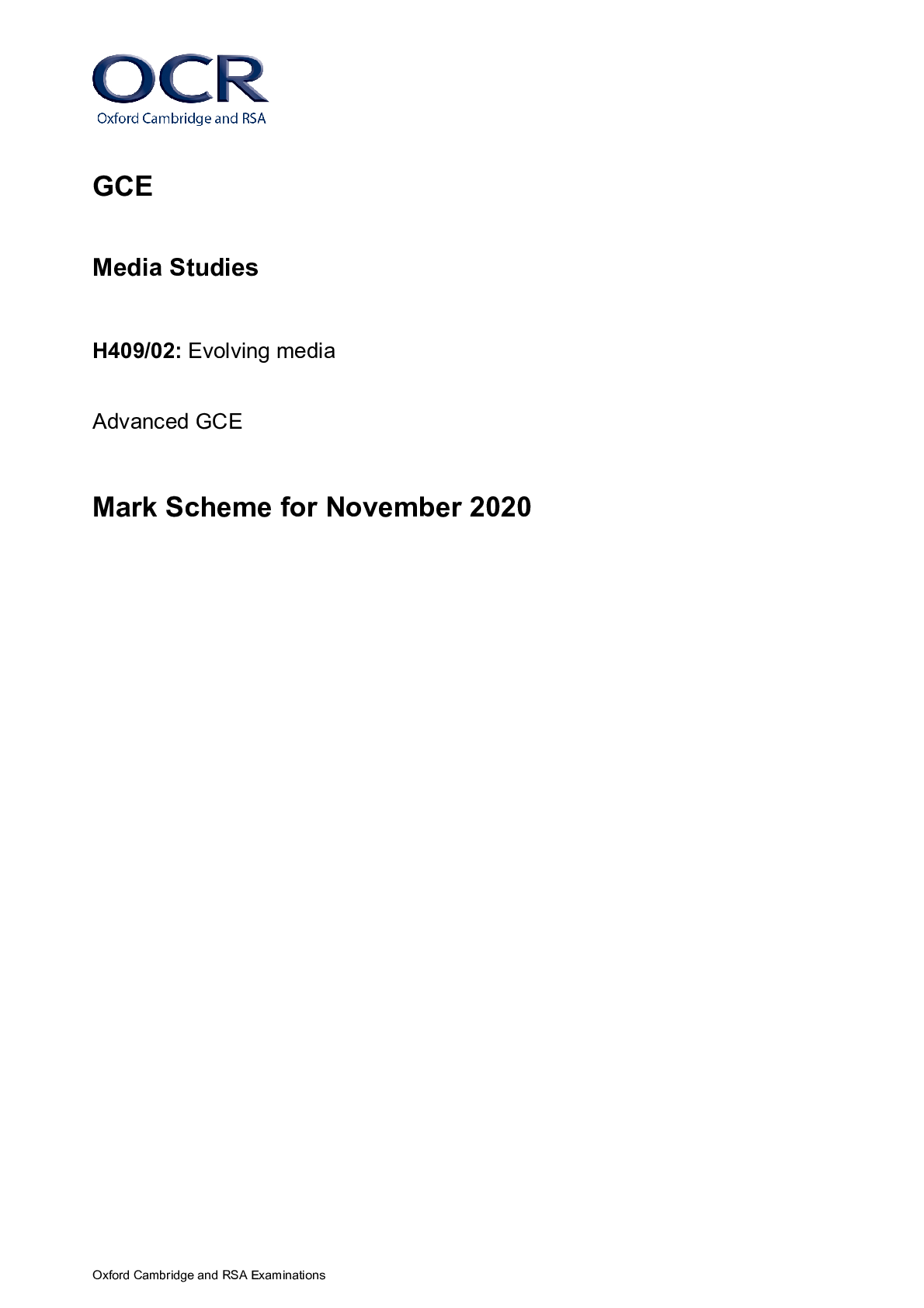
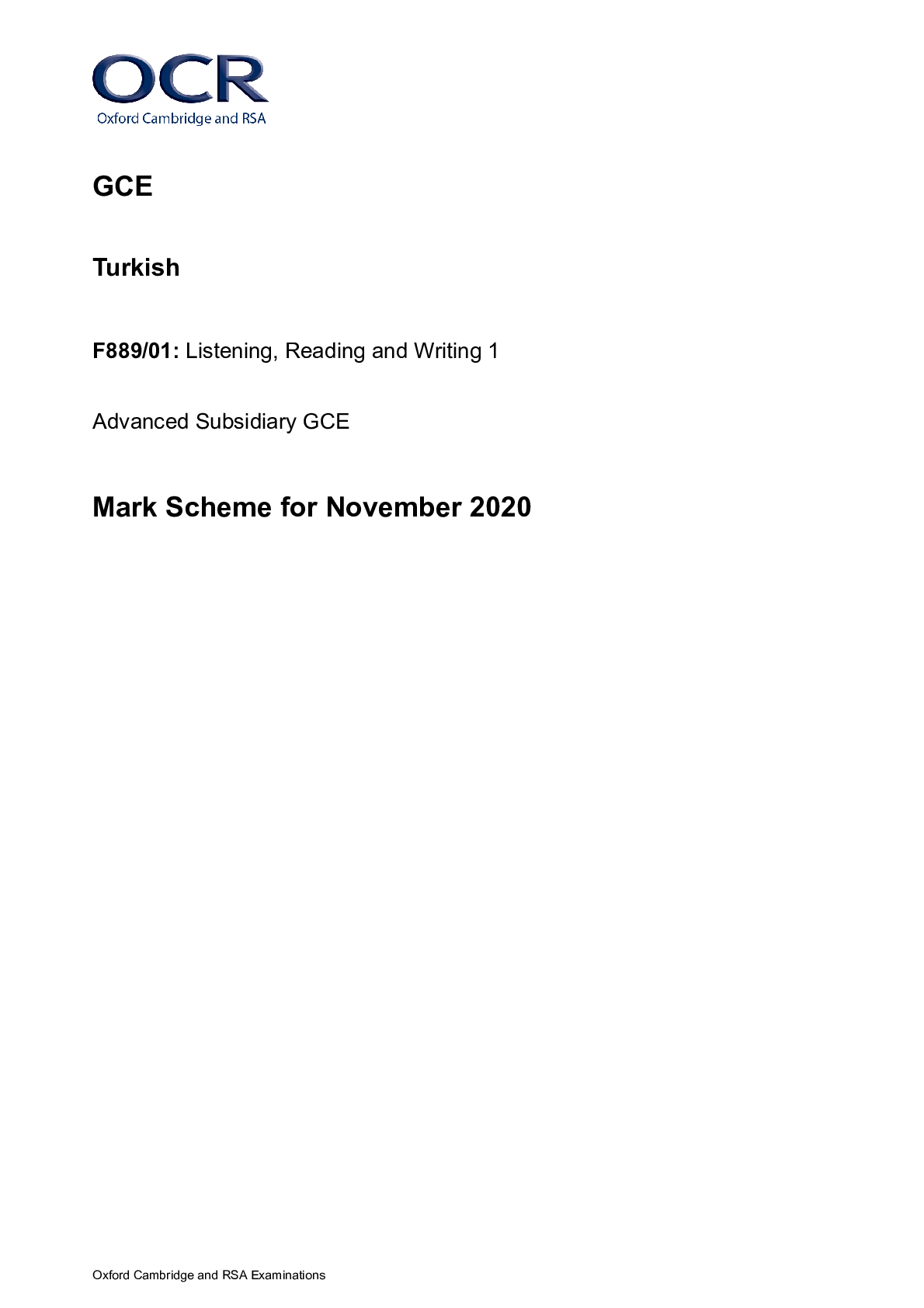
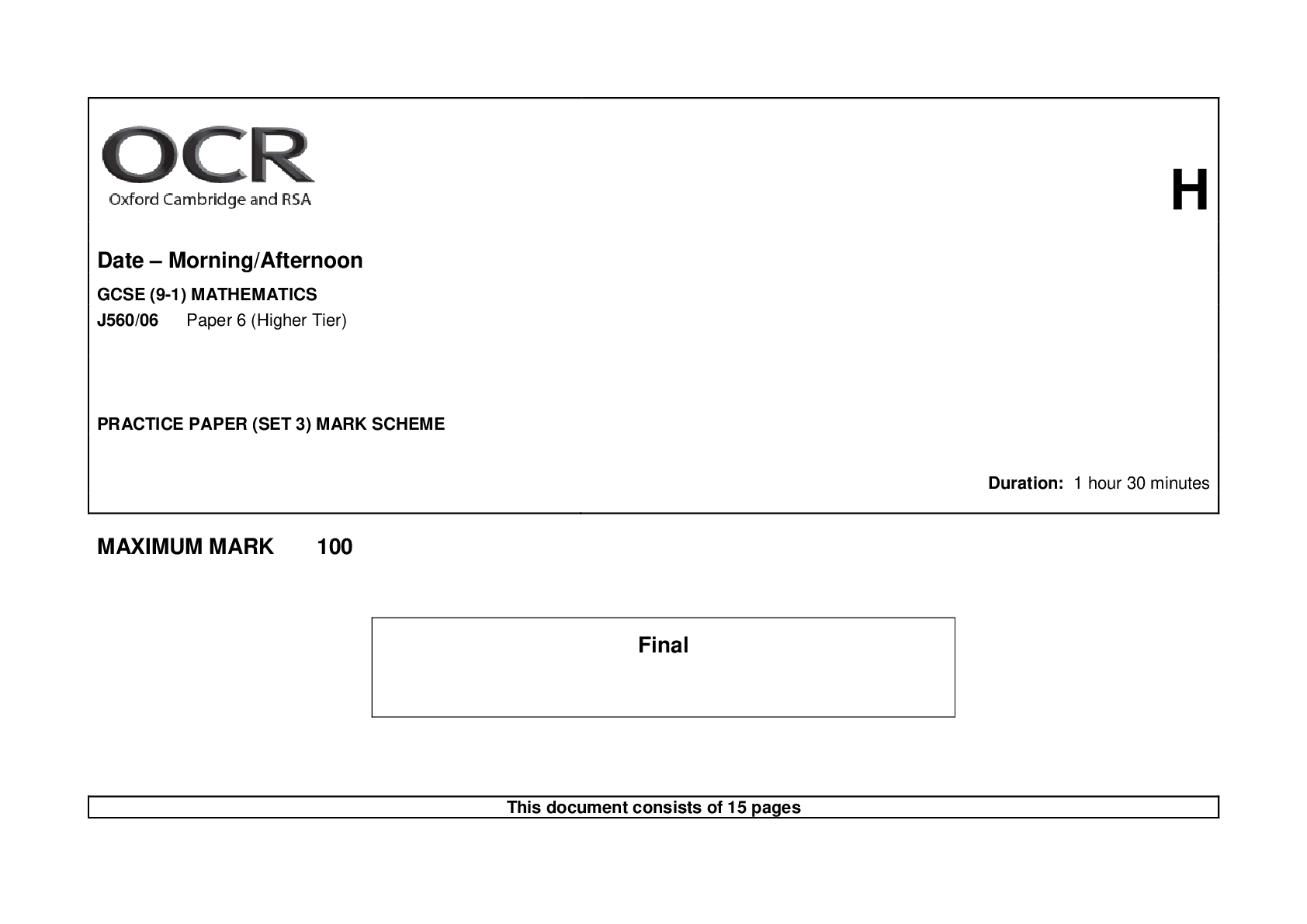



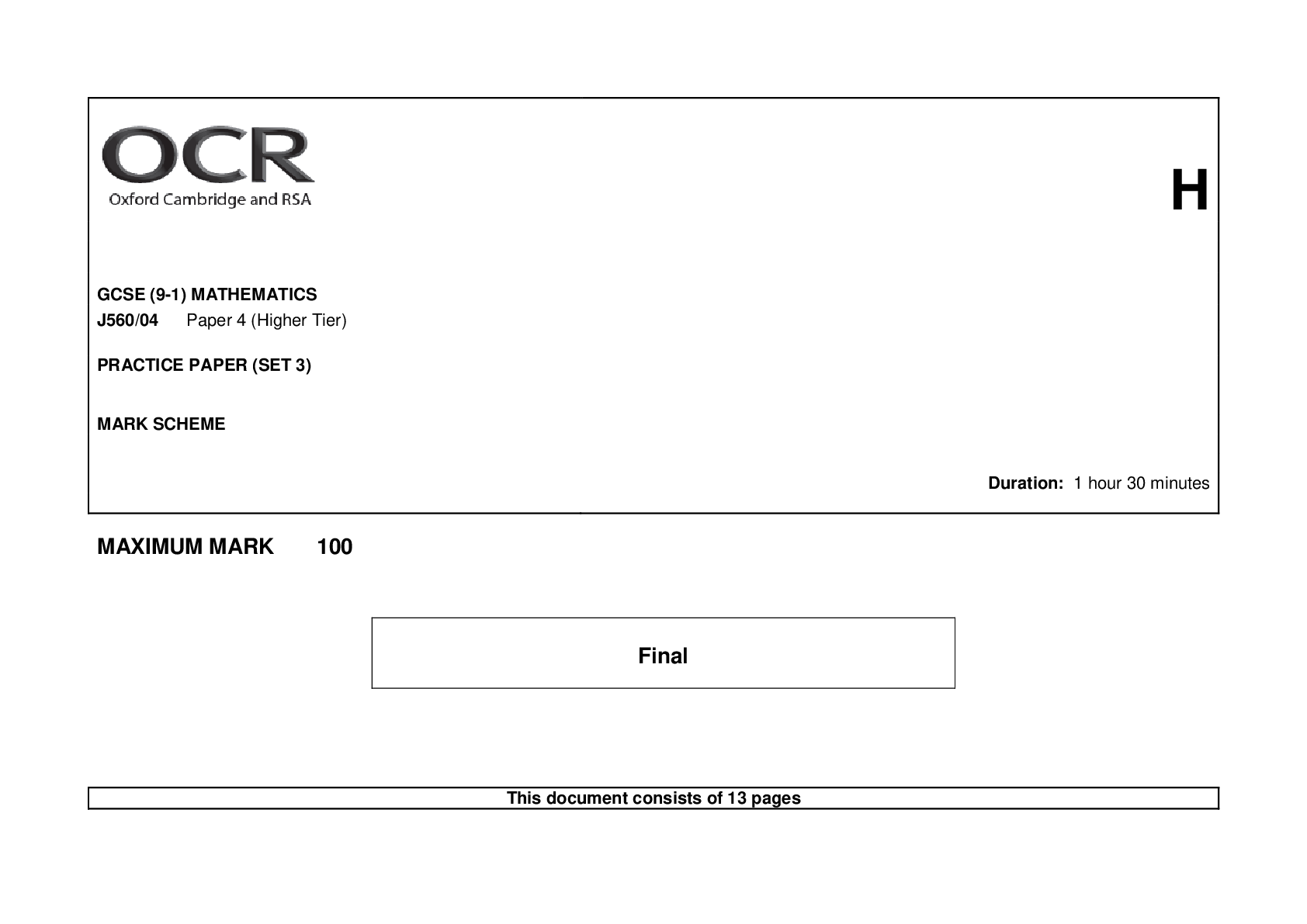



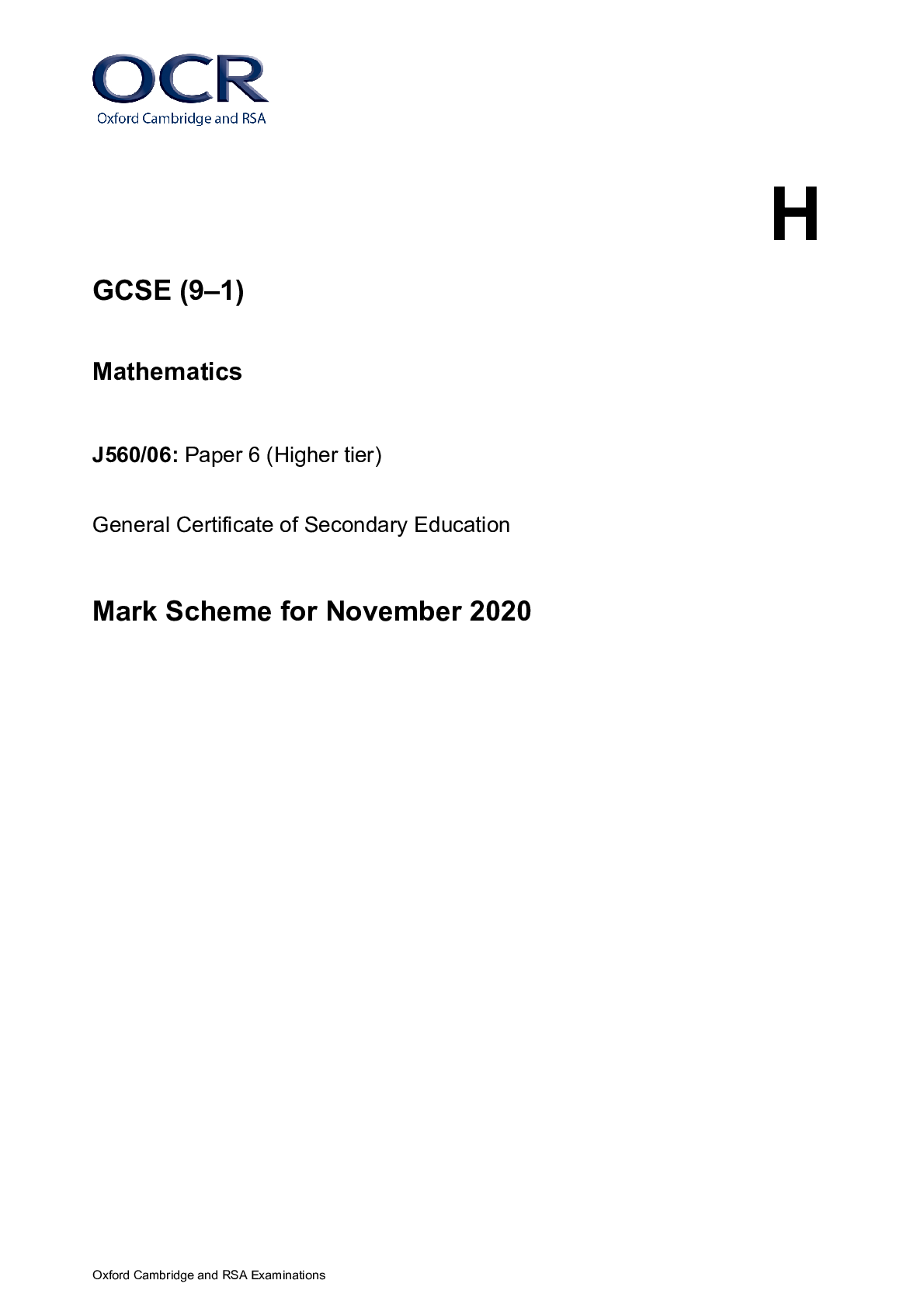
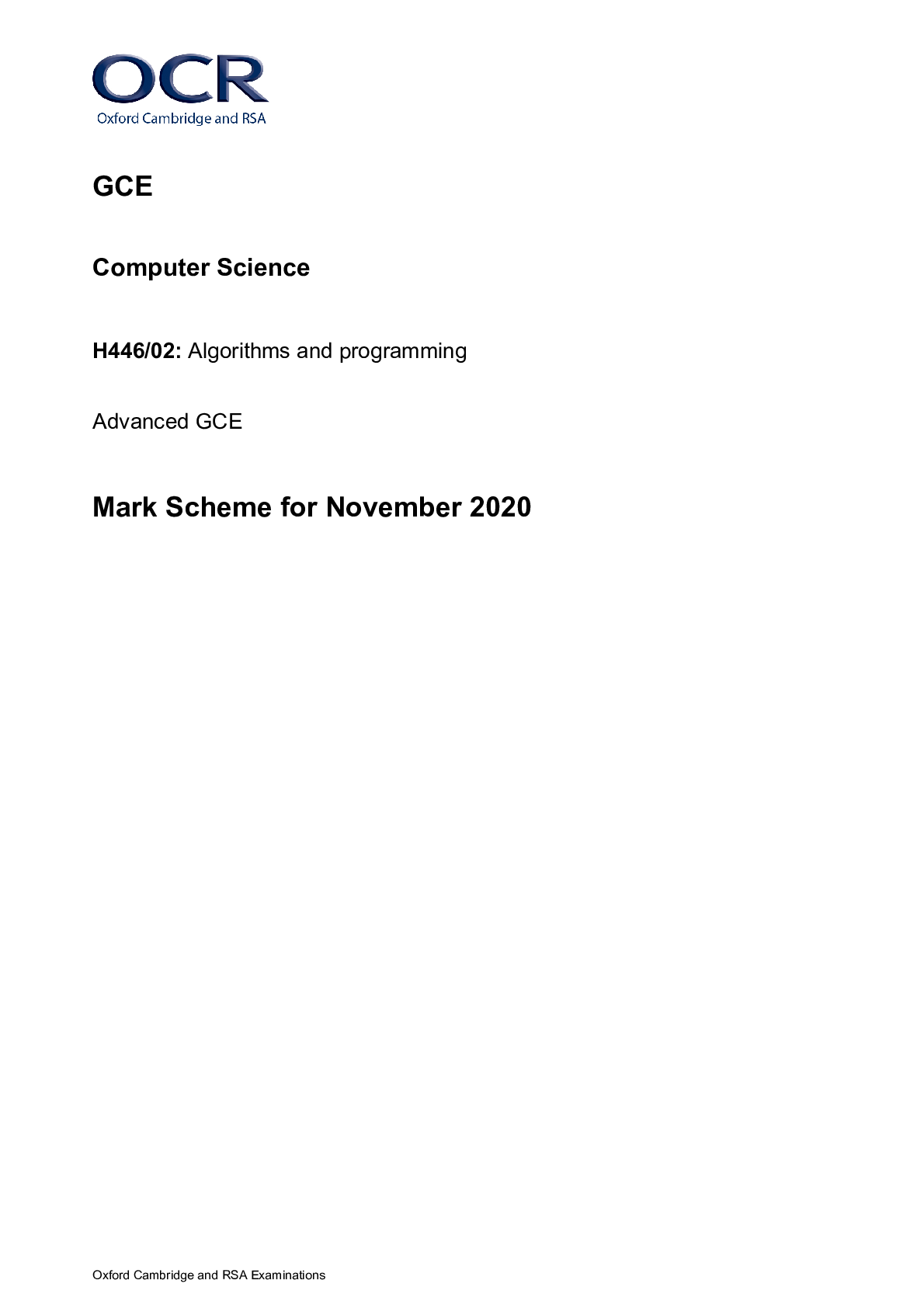
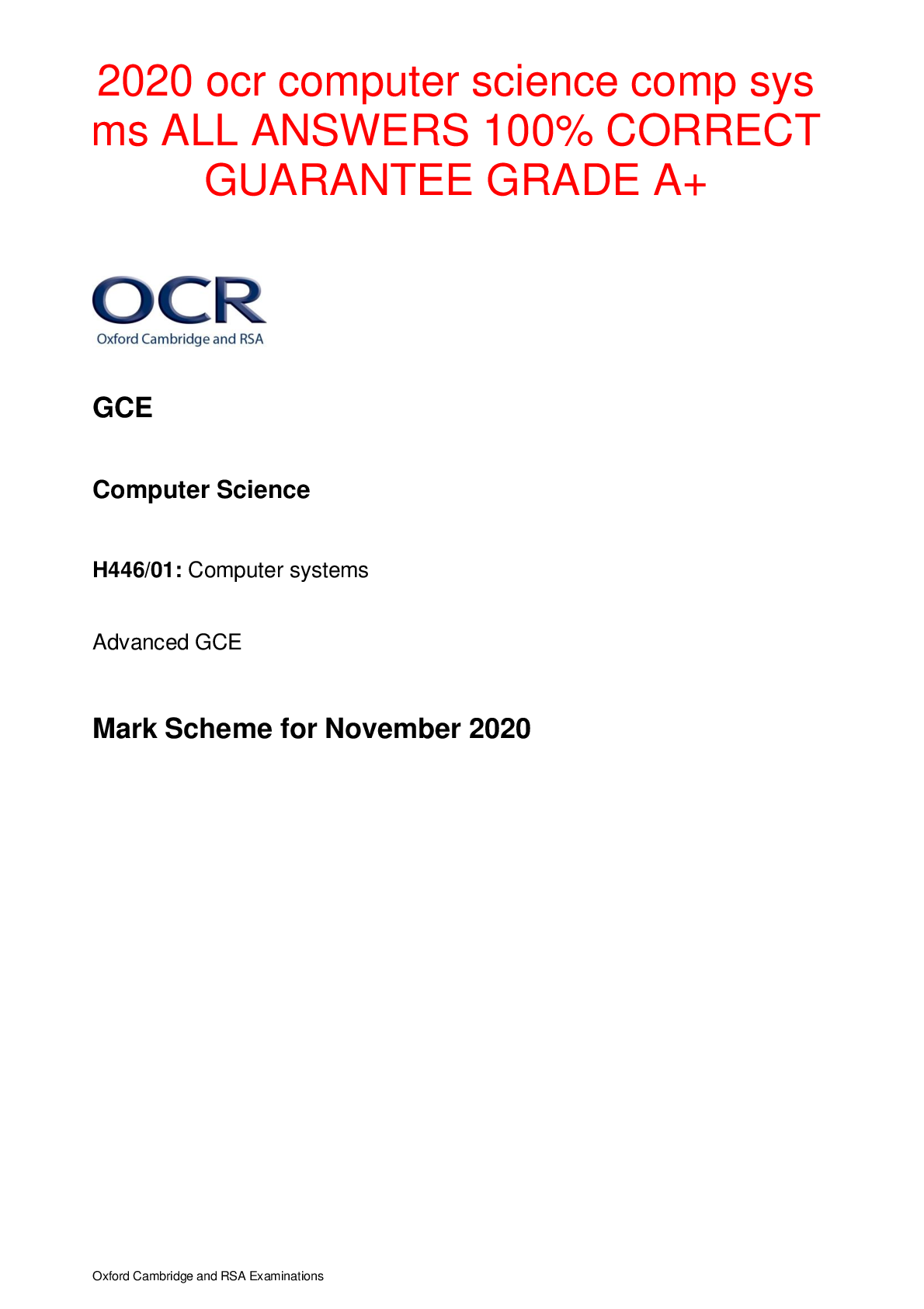

.png)
